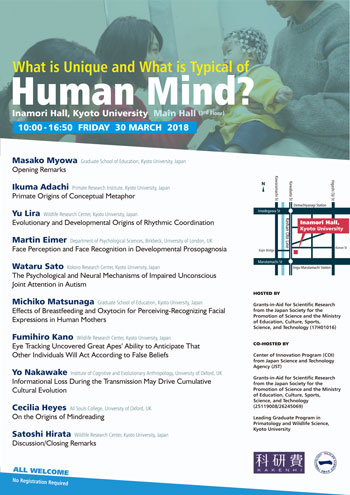
What is Unique and What is Typical of Human Mind?
稲盛財団記念館3階大会議室
Masako Myowa Graduate School of Education, Kyoto University, Japan
Ikuma Adachi
Primate Research Institute, Kyoto University, Japan
See Abstract ↓
Yu Lira
Wildlife Research Center, Kyoto University, Japan
See Abstract ↓
Martin Eimer
Department of Psychological Sciences, Birkbeck, University of London, UK
See Abstract ↓
Wataru Sato
Kokoro Research Center, Kyoto University, Japan
See Abstract ↓
Michiko Matsunaga
Graduate School of Education, Kyoto University, Japan
See Abstract ↓
Fumihiro Kano
Wildlife Research Center, Kyoto University, Japan
See Abstract ↓
Yo Nakawake
Institute of Cognitive and Evolutionary Anthropology, University of Oxford, UK
See Abstract ↓
Cecilia Heyes
All Souls College, University of Oxford, UK
See Abstract ↓
Satoshi Hirata Wildlife Research Center, Kyoto University, Japan
Primate Origins of Conceptual Metaphor
Ikuma Adachi
Primate Research Institute, Kyoto University, Japan
Evolutionary and Developmental Origins of Rhythmic Coordination
Yu Lira
Wildlife Research Center, Kyoto University, Japan
Face Perception and Face Recognition in Developmental Prosopagnosia
Martin Eimer
Department of Psychological Sciences, Birkbeck, University of London, UK
The Psychological and Neural Mechanisms of Impaired Unconscious Joint Attention in Autism
Wataru Sato
Kokoro Research Center, Kyoto University, Japan
Effects of Breastfeeding and Oxytocin for Perceiving-Recognizing Facial Expressions in Human Mothers
Michiko Matsunaga
Graduate School of Education, Kyoto University, Japan
Eye Tracking Uncovered Great Apes' Ability to Anticipate That Other Individuals Will Act According to False Beliefs
Fumihiro Kano
Wildlife Research Center, Kyoto University, Japan
Informational Loss During the Transmission May Drive Cumulative Cultural Evolution
Yo Nakawake
Institute of Cognitive and Evolutionary Anthropology, University of Oxford, UK
On the Origins of Mindreading
Cecilia Heyes
All Souls College, University of Oxford, UK